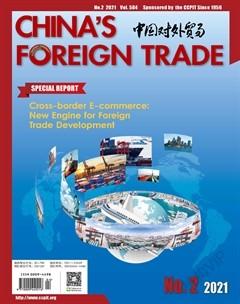9th China-Arab Business Conference and 7th Investment Seminar of the China-Arab States Cooperation Forum Open

CCPIT
9th China-Arab Business Conference and 7th Investment Seminar of the China-Arab States Cooperation Forum Open
On April 6, the 9th China-Arab Business Conference and 7th Investment Seminar of the China-Arab Cooperation Forum was held both online and offline in Beijing. Gao Yan, Chairperson of the China Council for the Promotion of International Trade (CCPIT), Dr. Kamal Hassan Ali, Assistant Secretary General for Economic Affairs of the League of Arab States, Mr. Mohamed Al-Rumaithi, Chairman of the Union of Arab Chambers, Dr. Hamdi Tabbaa, President of the Federation of Arab Businessmen, Amb. Ahcene Boukhelfa, Ambassador of Algeria to China/Dean of the Arab Diplomatic Corps in China, and Li Yong, Director General of the United Nations Industrial Development Organization attended the opening ceremony and delivered speeches.
Gao Yan pointed out that the thriving and fruitful cooperation between the Chinese and Arab industrial and commercial communities continues to demonstrate the commitment of both parties to advancing mutually beneficial cooperation and achieving common prosperity. As an important platform for business exchanges, the conference will further unleash the potential of Chinese-Arab economic and trade cooperation. The CCPIT is ready to serve as a bridge between the Chinese and Arab industrial and commercial circles by gathering strength from both parties. Moreover, both sides will jointly build a Chinese-Arab community with a shared future in the new era, and achieve breakthroughs in the Chinese-Arab strategic partnership.
Kamal Ali said that China and the Arab League have long been committed to deepening Chinese-Arab relations, and that Arab countries have a lot to learn from Chinas successful experience in coordinating its pandemic prevention and control with economic and social development. In recent years, Chinese-Arab economic and trade cooperation has come a long way, and it is believed that this conference will facilitate pandemic responses by both sides, as well as facilitating cooperation in trade, investment and other fields.
Mohamed Rumehi argued that China has proved to be hugely appealing to foreign investors as an important investment destination for Arab countries. China has a powerful manufacturing capacity and Chinese products are highly competitive in the Arab market. There are also broad prospects for cooperation in terms of trade, investment, science and technology, infrastructure, health, etc.
Hamdi Taba noted that coordination and unity are required from both China and Arab countries to overcome the adverse socio-economic impacts exerted by the pandemic. The investment and economic cooperation between the two sides enjoy tremendous potential, and the digital economy, infrastructure, and agriculture are all areas for further cooperation.
Ahsan Bukhalifa stated that the conference would be critical in building mutually beneficial Chinese-Arab relations that deliver winwin results. The two sides jointly held the conference in spite of the consequences of the pandemic, which is a positive sign for further advancing long-term cooperation between China and Arab countries. It is hoped that Arab entrepreneurs can seize the opportunities brought about by Chinas implementation of the 14th Five-Year Plan and the construction of a new “dual circulation” development pattern.
Li Yong noted that this conference will help Chinese and Arab entrepreneurs cement their partnership, create opportunities for cooperation, and fully tap into the industrialization potential of China and Arab countries to boost cooperation in terms of investment, technology and innovation.
The 2nd Meeting of the China Pavilion Organizing Committee for the Expo 2020 Dubai Held in Beijing
On April 2, the 2nd Meeting of the China Pavilion Organizing Committee for the Expo 2020 Dubai was held in Beijing. Gao Yan, the Chairperson of the China Council for the Promotion of International Trade (CCPIT) and Director of the China Pavilion Organizing Committee attended the meeting and delivered a speech. Zhang Shenfeng, Vice Chairman of the CCPIT and Deputy Director of the Organizing Committee, presided over the meeting. The meeting included a brief on the preparatory work and reviewed the presentation of the China Pavilion before further research and work arrangements were made. Representatives of the members of the Chinese Pavilion Organizing Committee, including the Publicity Department of the CPC Central Committee, the Ministry of Foreign Affairs, the Ministry of Science and Technology, the Ministry of Industry and Information Technology, the Ministry of Finance, the Ministry of Commerce, and the Ministry of Culture and Tourism of the Peoples Republic of China, also attended the meeting. Representatives from the National Health Commission of the Peoples Republic of China, the China National Space Administration and Beijing Organizing Committee for the 2022 Olympic Winter Games, as well as Sha Xiaolan, the Artistic Director of the China Pavilion, also attended the meeting.
Gao Yan pointed out that the Party Central Committee and the State Council attach great importance to Chinas participation in the Expo 2020 Dubai. Chinese General Secretary Xi Jinping and UAE leaders reached an important consensus on Chinas support for the UAE in holding the first World Expo in the Middle East. All members involved must improve their political awareness, ensure the safety and efficiency of the event, strengthen coordination, and ensure the full implementation of construction, exhibition, presentation, supportive activities, news coverage, pandemic prevention and control to a high standard and a high quality, thus contributing to closer China-UAE relations, the joint construction of the Belt and Road Initiative, and the building of a community with a shared future for mankind.
FIGURES
9.6 trillion
Chinas fixed asset investment reached RMB 9.6 trillion (USD 1.47 trillion) over the first quarter, up by 25.6% year-on-year and approximately 2.9% according to the two-year average, the National Bureau of Statistics said. Fixed asset investments, excluding those in agriculture, rose by 1.51% comparing with February.
10 billion
By the end of 2020, green loans and green bonds in China totaled USD 1.8 trillion and USD 125 billion, respectively, ranking the worlds largest and second-largest. More than 40 carbon-neutral bonds have been issued, with a total volume of over USD 10 billion.
20 billion
Chinas 2021 box office revenue exceeded RMB 20 billion(USD 3 billion), which is almost equal to the total ticket sales for the whole of 2020.
24.5%
Chinas industrial output, an an important economic indicator, rose 24.5% year-on-year in the first quarter of this year, as the countrys industrial production rebounded steadily, according to the National Bureau of Statistics.
18.3%
Chinas economy grew by 18.3% year-on-year in the first quarter of the year, versus 6.5% in the last quarter of 2020, thanks to last years low comparison base and a steady momentum of recovery, the National Bureau of Statistics said.
302.47 billion
The Ministry of Commerce reported that the first quarter of 2021 saw the countrys actual use of foreign investment hitting RMB 302.47 billion(USD 46.35 billion), up 39.9% year-onyear.
RMB 20 million
Chinas large manufacturing firms with an annual business turnover of at least RMB 20 million (approximately USD 3.06 million) will all have introduced digitalization by 2035, said a draft issued by the Ministry of Industry and Information Technology.
92.5%
China accounted for 92.5% of Mongolias total exports and 39.1% of its total imports in the January-March period.
61.8%
Chinas exports to the United States grew by 41.6% on a yearly basis in March, while its imports from the U.S. surged by 61.8%, according to the Ministry of Commerce.
RMB 302.47 billion
The first quarter of 2021 saw Chinas actual use of foreign direct investment hitting RMB 302.47 billion (USD 46.38 billion), according to Ministry of Commerce.
27
Of the 50 major goods monitored by the government, including seamless steel tubes, gasoline, coal, fertilizer and certain chemicals, 27 saw an increase in their prices, while 22 posted lower prices, and the price of one remained unchanged, according to the National Bureau of Statistics.
20.74%
An index tracking 69 carbon neutral-related A shares jumped by 20.74% to 1048.82 by the end of March, while the CSI 300 index fell 5.4% to 5048.36, according to market tracker Wind Info.
QUOTES
Chinas continuing reforms toward high-quality, sustainable, and balanced growth can also contribute to lowering carbon emissions.
—IMF Managing Director Kristalina Georgieva
Advanced manufacturing clusters, however, are based not just on physical proximity between industrial enterprises, but on deeper cooperation between companies to promote the development of local economies.
— Cheng Nan, Director of the Planning Institute at the China Center for Information Industry Development
China is at a key stage in which it is transitioning from rapid development to high-quality development. These moves will vitalize the economy and foster sustainable and long-term development.
—Chen Yuyu, a professor of economics at Peking University
China will not shut its door to opening-up, but will open up even more to the outside world… China will integrate itself deeper into the world economy, offering huge growth opportunities for other nations.
— Ning Jizhe, Deputy Head of the National Development and Reform Commission
In the medium and long term, the application of new technologies including 5G, big data and artificial intelligence will eventually provide support for intercity railways involving intelligent transportation, for example, intelligent dispatching commands, digital production operation and maintenance, and passenger services for specific groups.
— Xie Xiaowen, a researcher with the China Communications and Transportation Association
As the worlds two largest economies, the essence of economic and trade relations between China and the US is being mutually beneficial and win-win.
— Gao Feng, spokesman for the Ministry of Commerce
POLICIES
China Offers Rule-of-law Safeguards for Market Entities
A State Council executive meeting passed a draft regulation on the registration management of domestic market entities. This is aimed at providing rule-of-law safeguards for developing market entities and boost fair competition.
Throughout the span of the 13th Five-Year Plan (2016-2020), more than 60 million new market entities were created. This has enhanced economic vitality and created numerous jobs, according to the meeting, which was chaired by Premier Li Keqiang.
China will continue to deepen its reforms, seeking to streamline administration and delegate power, improve regulations, upgrade services, and optimize the market-entity registration management system, according to the meeting.
The draft has detailed unified regulation measures on the registration of various market entities, including companies, individually-owned businesses and farming cooperatives.
The draft has made it more convenient for market entities to register, with both application materials and procedures being streamlined.
Efforts should also be made to promote one-stop services, the online processing of registration applications and inter-provincial approval, according to the meeting.
Market entities must register with their real names and be responsible for the authenticity, legality and validity of the materials they submit.
The draft also clarified the legal responsibilities and punishment for illegal acts in order to safeguard market order, according to the meeting.
Chinas Central Bank to Double Down on Green Finance
Chinas central bank will implement a slew of measures to improve its support for green finance, according to Yi Gang, governor of the Peoples Bank of China(PBOC).
The PBOC plans to launch a support toolkit to provide low-cost funds for carbon emission reduction, and it will also support green finance through a host of measures ranging from commercial credit ratings and deposit insurance rates to collaterals for open market operations, the governor said.
The international community is forming a broad consensus on tackling climate change. China has announced its goal of peaking carbon emissions by 2030 and achieving carbon neutrality by 2060.
“Achieving these goals requires a comprehensive economic transition, and green finance can be an accelerator in this process,”Yi said at a high-level seminar on green finance and climate policy held by the PBOC and the International Monetary Fund.
“In a nutshell, central banks could contribute to the net-zero goal in many ways, for example, by developing a strong policy system, a diversified market system, and enhancing international coordination,” he added.
The PBOC attaches great importance to green finance and has put in place an initial policy framework for green finance, Yi also noted.
Central SOEs to Boost R&D Spending
Chinas centrally-administered Stateowned enterprises will invest more in research and development to secure a higher production efficiency and income during the period of the countrys 14th Five-Year Plan (2021-25), while keeping liabilities under control, the countrys top State-asset regulator said.
The government will guide central SOEs to further seize the opportunities generated by this new round of technological revolution and industrial transformation during this period. Their focus will be on key areas of emerging industries with slight growth potential such as digital platforms and sharing economies. They will cultivate new growth drivers, said Peng Huagang, Secretary-general of the State-owned Assets Supervision and Administration Commission of the State Council.
“We will leverage the advantages of massive production data and rich application experiences of central SOEs to accelerate the digital transformation of traditional industries and infrastructure,” he said, adding that the country will also promote the next level of integration between the digital economy and the real economy, as well as accelerating 5G to empower thousands of industries and achieve large-scale commercial use of 5G across the country.
Central SOEs investment in strategic emerging industries surged by 21.6% on a yearly basis to RMB 1.16 trillion (USD 177.71 billion) in 2020, accounting for 22.1% of their total annual investment amount.
- China’s foreign Trade的其它文章
- Chinese Elements Highlight the Charms of Fashion
- Post-epidemic Demand for Talent Illustrates New Trend
- The Number of Overseas Students Returning to China Has Doubled
- Insight into the Trends in Chinese Enterprises Affected by the Pandemic
- China and Thailand Discuss Innovative Investment Online
- Feet Firmly on the Gas Pedal in GBA

